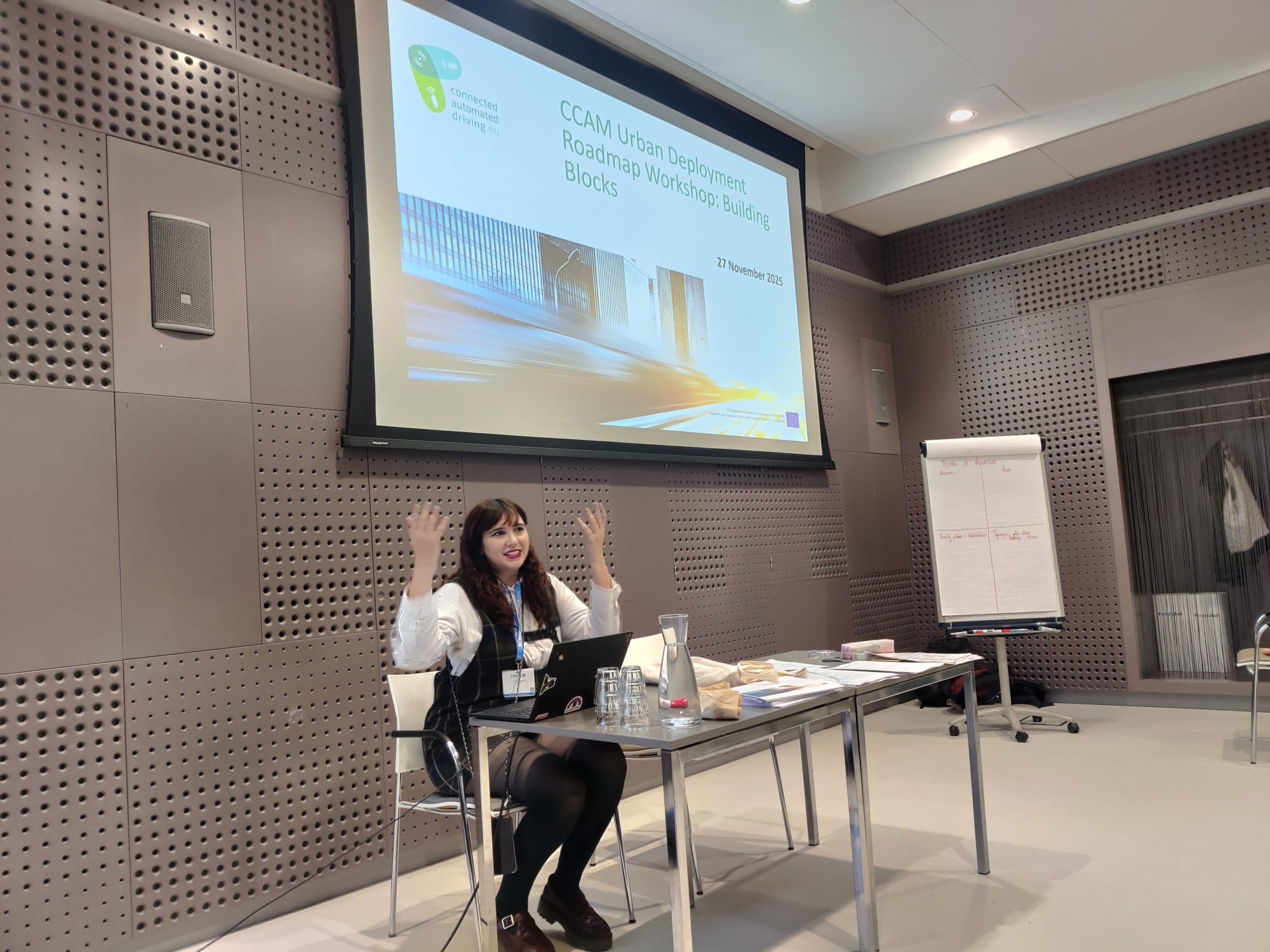The CONDUCTOR project – Fleet and traffic management systems for conducting future cooperative mobility

With the rise of connected, automated, and shared mobility services, transport systems must balance efficiency, accessibility, and sustainability while managing increasing demand for both passenger and goods movement. Traditional traffic management approaches, designed for simpler networks, struggle to adapt to this dynamic, data-rich, and multimodal environment.
The CONDUCTOR project – Fleet and traffic management systems for conducting future cooperative mobility – addresses this challenge by developing and demonstrating a new generation of tools for orchestrating future mobility. Its aim is to enable efficient and globally optimal transport of passengers and goods through seamless multimodality and interoperability. By dynamically balancing traffic demand and applying priority-based management to both automated and conventional vehicles, CONDUCTOR supports smarter, cleaner, and more inclusive transport systems.
At the core of CONDUCTOR’s vision is a holistic orchestration framework that connects traffic management and fleet operations with user needs. By integrating real-world data and advanced simulation, the project demonstrates how coordinated management of mixed traffic—combining public transport, automated vehicles, and logistics fleets—can improve efficiency, reduce congestion and emissions, and ensure that transport systems serve the needs of all citizens.
Use cases
The project is structured around three complementary use cases and their five pilots, each demonstrating a different aspect of advanced, high-level traffic and fleet management. Use Case 1 focuses on integrated traffic management and intermodality, testing cooperative control and dynamic prioritisation between various transport modes in Almelo (the Netherlands), Athens (Greece), and Madrid (Spain). Use Case 2 addresses fleet management and demand-responsive operations, showing how public and shared mobility fleets can adapt dynamically to real-time demand and network conditions. Use Case 3 explores urban logistics and multimodal freight integration, examining how passenger and goods transport can be coordinated within the same infrastructure to improve efficiency and sustainability.
Pilot 1
In Almelo, the pilot targets a major logistics corridor, aiming to reduce the number of stops that heavy-duty vehicles make at traffic signals and thereby lower emissions, delays, and fuel consumption. To achieve this, 27 intelligent traffic light controllers (iTLCs) are deployed, capable of two-way communication (V2I and I2V) with trucks. Truck drivers can request Freight Signal Priority (FSP) when approaching intersections; the iTLCs evaluate these requests against real-time traffic conditions and may grant priority by adjusting signal phases (such as green extension or early green) to maintain smoother progression.
The pilot assesses performance across multiple dimensions. For freight operators, it examines improvements in travel time, reduced stops, energy savings, and driver experience. For general traffic and other road users, the pilot analyses potential trade-offs, such as whether granting priority to trucks can be achieved without degrading overall traffic flow or fairness. Governance and stakeholder perspectives are also part of the evaluation, as the system must balance different road user types transparently and safely.
Pilot 2
The Athens pilot is deployed along Alexandras Avenue, a multimodal artery with 14 signalised intersections, 21 bus stops, and services from 18 public transport lines. It aims to synchronise and optimise operations across buses, tram/metro, and on-demand services by dynamically adjusting schedules, traffic signals, and lane usage. The system uses real traffic data (loop detectors, bus telematics) and predictive models to coordinate signal control, allocate road space flexibly, and support rescheduling and rebalancing strategies in real time.
Simulations calibrated to actual Athens conditions evaluate the impact on key metrics such as door-to-door travel times, punctuality, waiting times, and emissions. The pilot also benchmarks its ETA prediction module, incident management, and multimodal scheduling capabilities. It demonstrates how adaptive, cooperative traffic and fleet control can improve alignment between public transport and broader network flows, reducing delays, enhancing service reliability, and enabling more seamless intermodal journeys.
Pilot 3
The Madrid pilot focuses on the M-30 ring road, a 32 km urban motorway encircling the central districts of Madrid, and its adjacent urban network. It uses connected and automated vehicle (CAV) integration to improve network resilience and recovery performance under both planned and unplanned disruptions. The pilot is conducted in a simulation environment (using Aimsun Next), exploring how varying levels of CAV penetration interact with traditional traffic to manage congestion, reroute flows, and stabilise operations during incidents such as roadworks or accidents.
The simulation implements dynamic routing, speed adaptation, lane management, and access control strategies, along with prioritisation for emergency vehicles and evacuation planning, to generate adaptive route guidance and control policies in response to disruptions. Key performance indicators include travel times, delays, traffic flows, vehicle speeds, emissions, and network recovery metrics.
Pilot 4
Use Case 2 implements a cross-border demand-responsive transport (DRT) system covering Slovenia, Italy, Croatia, and Austria, aiming to improve under-served connections between urban centres and major airports. The pilot tests three strategic shuttle routes: Ljubljana – Trieste, Ljubljana – Zagreb, and Maribor – Vienna, chosen for their operational relevance and complexity. It combines real-world field operations with simulation experiments to compare traditional (static) planning approaches with the dynamic, adaptive planning model of the CONDUCTOR platform, particularly under conditions of demand surges, traffic disruptions, and last-minute bookings.
The pilot integrates booking, planning, routing, and monitoring subsystems. AI-based demand prediction and continuous planning algorithms dynamically adapt shuttle routes to optimise travel time, occupancy, and efficiency. It also leverages heterogeneous data streams—such as airport schedules, real-time traffic, weather, and booking patterns—to proactively reroute or reassign vehicles when disruptions occur. Expected benefits include enhanced cross-border accessibility, lower emissions through optimised routing and higher load factors, improved passenger experience (shorter waits and more responsive services), and operational efficiency through reduced deadheading and idle times.
Pilot 5
In the Madrid pilot, the challenge of last-mile parcel delivery is addressed by integrating freight transport with demand-responsive passenger services (DRT-CCAM). Passenger and goods transport are combined and coordinated within the dense urban core (inside the M-30 ring). Under baseline conditions, parcel delivery and DRT operate independently. In more advanced integration scenarios, only parcels that align with existing passenger service routes are bundled; in the most optimised scenario, routing is jointly determined based on combined passenger and parcel demand, both with and without parcel delivery time windows.
In all scenarios, passenger transport is always given scheduling priority to ensure that mobility service quality is preserved. The pilot is validated through simulation using Aimsun Next and Aimsun Ride, comparing performance across scenarios of increasing complexity and demand. Key performance indicators include the number of vehicles deployed, idle trips, fuel consumption, emissions, average travel time, and total distance travelled.
More on CONDUCTOR:
https://www.linkedin.com/company/conductor-he
https://twitter.com/CONDUCTOR_HE
Resources:
The CONDUCTOR key publications include:
- Nisyrios, E., Matthaiou, A., Chau, M.LY. & Gkiotsalitis, K. (2025). Investigating the preferences for autonomous vehicle use in European road transport: a binary logit model. npj Sustainable Mobility and Transport 2, 36.
- Rožanec, J. M., Petelin, G., Costa, J., Cerar, G., Bertalanič, B., Guček, M., Papa, G.& Mladenić, D. (2025). Dealing with zero-inflated data: Achieving state-of-the-art with a two-fold machine learning approach. Engineering Applications of Artificial Intelligence, 149, 110339, ISSN 0952-1976.
- Papa, G., Hribar, R., Petelin, G. & Vukasinovic, V. Advanced computing to support urban climate neutrality. Energy, Sustainability and Society 15, 16 (2025).
- Chau, M.L.Y., Gkiotsalitis, K. (2025). A systematic literature review on the use of metaheuristics for the optimisation of multimodal transportation. Evolutionary Intelligence 18, 36 (2025).
- Luan, X., Eikenbroek, O., Corman, F., & van Berkum, E. (2024). Passenger social rerouting strategies in capacitated public transport systems. Transportation Research Part E: Logistics and Transportation Review, 188, 2024, 103598, ISSN 1366-5545,.
- Petelin, G., Hribar, R., & Papa, G. (2023). Models for forecasting the traffic flow within the city of Ljubljana. European Transport Research Review, 15(1), 1-20.
- Eikenbroek, O. & van Berkum, E. (2025). A stochastic transit assignment with adaptive route choice. 10th International Symposium on Dynamic Traffic Assignment
- Ccesa-Quincho, M., Fajardo Calderín, J., Cantero, X., Masegosa, A. D. & Serrano, L. (2025). Clustering-Based Route Optimization for Mixed Ride-Sharing under HAIS 2025
- Farahmand, Z. H., Eikenbroek, O., Gkiotsalitis, K., & van Berkum, E. (2025). Multi-criteria Traffic Signal Control using Moduler Deep Reinforcement Learning. Transport Research Symposium 2025
- Farahmand, Z. H., Eikenbroek, O., Gkiotsalitis, K., & van Berkum, E. (2025). Improving Physics-based Car-following Models using Bayesian Convolutional Neural Networks. EWGT 2025
- Nisyrios, E., Matthaiou, A., Lai-Ying Chau, M. & Gkiotsalitis, K. (2025). Modelling European citizens’ preferences for autonomous vehicle adoption: insights for policy and intelligent mobility. ETC 2025
- Farahmand, Z. H., Eikenbroek, O., Gkiotsalitis, K., & van Berkum, E. (2024). High-Resolution Platoon Prediction for Coordinated Traffic Control along Urban Arterials. Euro Working group on Transportation 2024
- Nisyrios, E., Nikolopoulou, A., & Gkiotsalitis, K. (2024). The Dynamic Pickup and Delivery Problem with Crossdock for Perishable Goods. ECCOMAS 2024
- Petelin, G., Rožanec, J., & Papa, G. (2024). Traffic Forecasting With Uncertainty: A Case for Conformalized Quantile Regression. ECCOMAS 2024
- Papa, G., Massi, F., & Vukašinović, V. (2024). Fleet and Traffic Management Systems for Conducting Future Cooperative Mobility. ECCOMAS 2024
- Lanzi, P., Brambati, F., Giampaolo, N., & Spiller, E. (2024). User-centred design for CCAM: a Holistic Approach Combining Stakeholders and Users’ Needs with Regulatory Requirements. 10th Transport Research Arena
- Papa, G., Vukašinović, V., Sánchez-Cauce, R., Cantú Ros, O. G., Burrieza-Galán, J., Tympakianaki, A., Pellicer-Pous, A., Gosh, A., & Serrano, L. (2024). Fleet and traffic management systems for conducting future cooperative mobility. 10th Transport Research Arena
- Matthaiou, A., Nisyrios, E., Lai-Ying Chau, M., & Gkiotsalitis, K. (2024). Impact assessment of governance models on the integration of connected and autonomous vehicles. 10th Transport Research Arena
- Gkiotsalitis, K., Nikolopoulou, A. (2023). The Pickup and Delivery Problem with Crossdock for Perishable Goods. ITSC2023
- Wolf, F., Engelhardt, R., Zhang, Y., Dandl, F., & Bogenberger, K. (2023). Effects of Dynamic and Stochastic Travel Times on the Operation of Mobility-on-Demand Services. ITSC2023
- Hulleman, R. (2023). Sustainable Mobilityby providing Connected Mobility for all Modes of Transport. ITS European Congress

